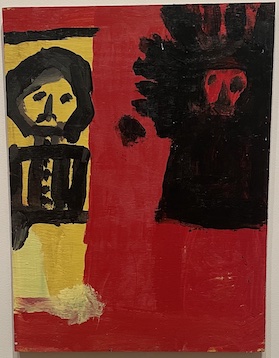Mary T. Smith facts for kids
Quick facts for kids
Mary Tillman Smith
|
|
|---|---|

Mary T. Smith and her paintings at her home in Hazelhurst, Mississippi
|
|
| Born |
Mary Tillman Smith
1905 |
| Died | 1995 Hazelhurst, Mississippi
|
| Nationality | American |
| Known for | Painting |
| Movement | Contemporary Art |
Mary Tillman Smith (1904–1995) was a talented artist from the American South. She taught herself how to paint and spent most of her life in Mississippi. Mary created bright, bold, and expressive artworks, often using house paint on wood or tin.
Her paintings show unique figures in strong colors, sometimes with dots and dashes that make them seem to move. She also added mysterious words to her art, all on colorful backgrounds. Mary's work is shown all over the world. Famous museums like the National Gallery of Art in Washington, D.C., and the Metropolitan Museum of Art collect her art. Many other museums also own her pieces, including the High Museum of Art and the Smithsonian American Art Museum. She had solo art shows in the United States and Europe. Mary is known as a "self-taught artist" from the South, like Thornton Dial and Nellie Mae Rowe.
Life Story
Mary Smith grew up as the daughter of sharecroppers, who were farmers who paid rent with a share of their crops. She was the third of thirteen children. From a young age, people noticed she was deaf. She finished fifth grade, which was hard because she felt alone, not being able to hear the world around her. But Mary found a way to express herself through drawing.
Mary got married twice. Her first marriage was short, to Gus Williams in 1922. Later, in the 1930s, she married John Smith. This marriage also ended quickly. Mary noticed her husband's year-end payment was much too low. When she complained about the missing money, John Smith "sent her away." Mary then moved to Hazelhurst, Mississippi, to live on her own. In 1941, she had a son named Sheridan L. Major. Mary worked as a gardener and did other jobs around people's homes until she retired in the 1970s.
In 1985, Mary had a stroke. This made it hard for her to speak and write. After the stroke, she could only create about two artworks a day. As she painted less, she earned less money. She stopped painting completely in 1991 and passed away in 1995.
Her Artworks

Mary Smith started painting in the late 1970s. She turned her home and garden, which was about one acre, into a huge outdoor art display. It was like a "spiritual autobiography" that everyone could see. Her art was very expressive and personal, showing ideas she had thought about for years. Once art collectors discovered Mary's work, she found it hard to paint fast enough to meet the demand.
Mary often used materials she could easily find, like plywood, corrugated tin, and other recycled items. In her earlier paintings, she sometimes used only one or two colors. Her unique figures remind some people of West African ceremonial masks. Many of her artworks tell a story or have a deeper meaning. Her art has been compared to artists like Jean-Michel Basquiat.
Mary's work was also very personal. She loved to paint pictures of her family, friends, and neighbors. Many of her paintings show figures with their arms raised. This pose often suggests strong feelings, like joy or a spiritual connection.
Later in her career, Mary's art included more geometric shapes and more colors. She often played with positive and negative space in interesting ways. Sometimes, she added words to her pictures. These words were often a bit mysterious. They formed her own "painting vocabulary" that showed and celebrated her world, both religious and everyday.
What People Said About Her Art
Artist and musician Lonnie Holley said: "Many women in the South worked as farm hands. Meeting Ms. Smith, seeing her amazing work and kindness, and how she praised the Lord every day, really touched me. I could feel all the power she put into her art. She had a tough life... She painted so boldly on any material she had. She filled her home and yard with her art. She couldn't hear very well, but she could say anything she needed to with a paintbrush. And she had a smile that would melt your heart."
William Arnett, who started the Souls Grown Deep foundation, also spoke about Mary's art. He noted how carefully she planned her paintings, even though they seemed spontaneous. She would layer colors, like black, then orange, then more black, and then red. This created a strong feeling between the dark and bright colors. He also pointed out that the faces in her paintings had different color combinations.
Arnett also shared an interesting fact about Mary's clothes and her art. Her closet was full of dresses that showed her every mood. She would wear white when she felt humble or painted religious scenes, like Christ surrounded by blood. White was like a uniform for serving God or trying to heal others. But when she painted lively portraits of friends or colorful tributes to her pets, or when she wanted to scold people for their faults, she would wear bright, colorful, zigzagging clothes. She used her art and her style to speak her mind.
Mary Smith stood her ground until she passed away in 1995 at the age of ninety-one. A poor, Black, uneducated, deaf daughter of a sharecropper became a major artist. Her work is now shown and collected all across the United States.
Selected Exhibitions
- Called To Create: Black Artists of the American South, National Gallery of Art, Washington, DC, September 18, 2022 – March 26, 2023. This show was put together by Harry Cooper.

